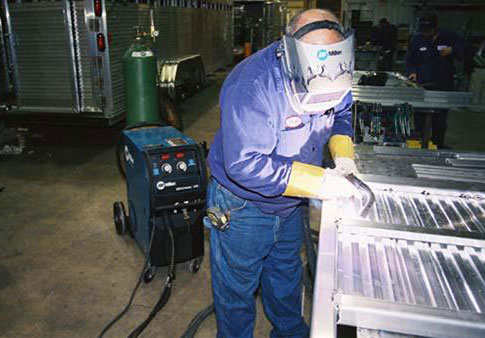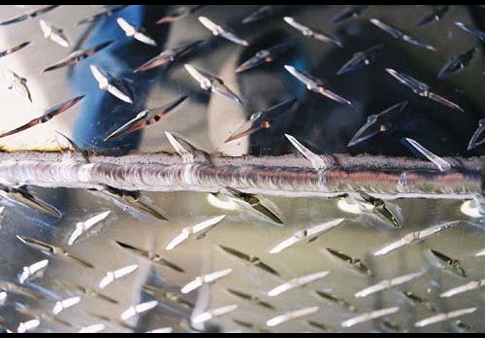Aluminum Trailer Manufacturer Increases Productivity
Nothing says customization like trailers for emus and miniature goats, but at Alum-Line, Inc., what the customer wants, the customer gets. The company, located in Cresco, Iowa, has more than 20 years of experience creating the best in custom aluminum products, from livestock trailers to truck bed toolboxes. As testimony to Alum-Line's superior design, engineering, workmanship, materials and customer service, it is experiencing its best sales in 10 years and growing like never before(increasing employees from 18 to 80 in about 12 months and planning the addition of three more facilities in 2005. With this increased growth comes a need to increase productivity without sacrificing weld bead quality.
"To keep up with demand, we purchased two Millermatic® 350P all-in-one MIG welders," states Randy Sobolik, trailer foreman, Alum-Line. As a result of switching to the pulsed MIG welding process, "We nearly doubled production of gates, toolboxes and other aluminum parts."
Welding aluminum can be a tricky business, and the spray transfer MIG welding systems used at Alum-Line were not doing the trick. Aluminum's inherent properties create welding challenges. First, it conducts heat about six times faster than steel; therefore, it requires higher amperages and faster wire feed speeds compared to steel. Second, aluminum has a relatively low melting point (1,220 degrees F). Excellent thermal conductivity coupled with a low melting point makes aluminum extremely susceptible to warping and burn-through.
 |
|
Chuck Watson, gate welder at Alum-Line, reports that pulsed MIG welding has eliminated burn-through on thin aluminum, such as this 1/8-in. thick panel.
|
Carl Deobald, a sales manager from Mississippi Welding Supply (a distributor of Miller products) had a solution: the Millermatic 350P, Miller's first all-in-one, inverter-based pulsed MIG welding system.
Pulsed MIG is a modified spray transfer process. With a traditional spray transfer method, drops of molten metal are continuously transferred across the arc, while in pulsed transfer the power source rapidly switches the welding output from high peak current to low background current. The peak current pinches off a droplet and propels it toward the weldment for good fusion. The background current maintains the arc, but it is too low for metal transfer to occur. Because there is no metal transfer, the weld puddle gets a chance to cool and freeze slightly.
"Because pulsed MIG is a cooler process, it minimizes burn-through and distortion. It also improves weld bead appearance," states Deobald. "Coupled with all of these benefits is its easy set up, which saves time and increases productivity. It is also a lot less expensive than industrial pulsed MIG power sources."
The Millermatic 350P offers built-in pulsed MIG programs for .035-and .047-in for 4000 and 5000 series aluminum wires and has a list price of $5,430, which saves 30 percent or more compared to an industrial power source, pulsing controls and bench-top style wire feeder. It is a perfect choice for manufacturers who do not need the high welding output or cost of a heavy industrial system, but still need great welding performance and productivity out of their welding power source.
"To begin pulsed MIG welding with the Millermatic 350P," says Deobald, "the operator simply selects the built-in program that matches the wire type and size and the unit automatically sets the pulse parameters. Once the desired arc length is set, the operator only needs to adjust wire feed speed to weld a different thickness of metal. In fact, one foreman at Alum-Line spent only a half an hour with the Millermatic 350P before becoming familiar enough with the machine to begin production welding."
Increased Productivity
One area where Alum-Line was facing productivity issues was in its gate welding cell. The trailer gates are 71" wide and 55" tall and made from extruded aluminum tubing that has a wall thickness of 1/8 in. (4 x 4 in. tubing for the sides, 2 x 2 in. for the top and bottom and a middle post, 1 x 2 for a second vertical support). On one side of the gate, running from top and bottom, 1/8-in. thick aluminum panels are welded into place (see photo #1). Chuck Watson, gate welder for Alum-Line was having problems with burn-through when less-than-optimal fit up occurred, such as when two sections of tubing met at a 45 degree angle. Watson had been using an old Miller Regency 200 CV power source paired with a Spoolmatic® 30 A spool gun. Because this power source can only weld in the spray transfer or short circuit transfer method (and short circuit is not suitable for welding aluminum), burn-through was inevitable, decreasing productivity and affecting the perceived quality of Alum-Line's products.
|
|
|
Derek Fortney, assistant foreman at Alum-Line, welds a tunnel box using the Millermatic 350P. Before the Millermatic 350P, Fortney would TIG weld the outside edges. Now he completes the job 30 percent faster.
|
When attempting to weld where gaps exist, burn-through often occurs because of aluminum's low melting point. When two pieces of metal fit snugly, the base metal generally absorbs the heat, but because the edges of the gate's aluminum tubing is just 1/8-in. thick, there was not enough metal at the edges and the arc melted the edges away.
The Millermatic 350P's pulsed MIG capabilities solved the problem. The background current of the pulse cycle is set at a level that maintains the arc but is too low for metal transfer to occur. This lowers overall heat input, which enables Watson to carry the weld puddle across the gap.
"Burn-through was causing a lot of productivity issues because of the time it would take to go back and fix the problem," states Watson. "When we switched over to using the Millermatic 350P, burn-through was eliminated. I can now weld a gate in about 30 minutes where it took me about 60 minutes before."
Watson also notes that he uses a slower wire feed speed with pulsed MIG (about 260 inches per minute), which gives him more time to place the weld bead where he wants it.
"The Millermatic 350P has a SharpArc' control that lets me adjust arc length," adds Watson. "Normally, I set it at 0, which lets me hold a shorter arc, which is the way I've always welded. However, for placing a weld bead in a corner(where the gun nozzle won't let me get close to the joint(I can turn the SharpArc up to 25 or even 50. This increases arc length. I can hold the gun back a little bit but still get into the corner."
Weld Bead Appearance Maintained
The Alum-Line folks over at Plant One were experiencing their own set of problems before the introduction of the Millermatic 350P. Plant One is in charge of manufacturing custom-made toolboxes. Each varying in size, Plant One deals mostly with .080-, .100- and 1/8-in. aluminum, producing hundreds of toolboxes every month.
When Alum-Line welded certain toolbox styles together, such as tunnel boxes (see photo #2) they would TIG weld the outside and then stitch (MIG) weld the inside for strength and durability. With the Millermatic 350P, much of the inside stitch welding is eliminated and the outside still provides a TIG-like weld bead appearance.
"We're getting a lot more penetration without bleed-through on the backside using the Millermatic 350P. This enables us to cut down on inside stitch welding, saving us time and increasing our productivity," states Perry Thomas, Plant One foreman. "With Pulsed MIG, the welding time is at least one-third faster and we are also getting a quality weld bead, which is important from a cosmetics standpoint (see photo #3)."
Pulsed MIG provides good weld bead appearance because the tiny molten droplets do not create spatter. Also, because the weld puddle cools in between pulses and freezes faster, operators have better directional control over the weld bead. The puddle is less likely to sag or look excessively convex when welding out-of-position. In fact, operators have so much control with pulsed MIG that they can create beads with a TIG-like appearance.
Pulsed MIG also creates less distortion. There is less arc "on time" with pulsed MIG welding and therefore the amount of heat on the base metal is decreased. Conversely, when TIG welding aluminum, arc "on time" is greater and produces more heat, which can bend and curve the aluminum.
Flexibility
Derek Fortney, assistant foreman at Alum-Line, has seen his fair share of tight corners when welding customized toolboxes. The Millermatic 350P allows Fortney the ability to easily tailor the arc to the application.
"I generally like to weld wider beads because I like their appearance and it helps me catch both plates when welding the outside corners of the toolbox, but when I need to get into tight corners, I really need a thinner weld bead to get good penetration at the root of the joint," states Fortney. To change arc cone width for the toolboxes, he sets the SharpArc control at 30.
 |
|
Because the pulsed MIG weld bead can provide a bead appearance that resembles TIG, welding time for Alum-Line is at least one-third faster without sacrificing quality.
|
Like Watson, Fortney uses the Millermatic 350P in a push-pull feeder configuration. In push-pull systems, a torque motor at the wire spool steadily feeds the wire, while a drive motor located in the gun pulls the wire and precisely controls wire speed at the arc. This maintains constant tension, so the wire feeds consistently, even when the cable is looped or goes through multiple 90-dgree angles. The push-pull system is lightweight, compared to spool guns, minimizing operator fatigue while maximizing productivity.
Alum-Line goes through approximately 500 lbs. of aluminum wire each month, and they have about 25 welding systems dedicated to aluminum. However, a spool gun is not designed for high volume aluminum welding and will wear out, decreasing wire feed performance and increasing maintenance costs. Further, when aluminum wire runs out, there is burn back to the contact tip. The operator not only has to change wire, but they also need to change contact tips, which can become costly and time consuming.
"The Millermatic 350P holds a 16-lb. (12-in. diameter) spool of wire vs. a 1-lb. (4-in.) that a spool gun holds. This means that Watson and Fortney can now weld 16 times longer than before, plus they are using fewer contact tips," notes Deobald.
The Millermatic 350P can be configured in a push-pull arrangement with Miller's XR™-Edge, XR-Pistol Grip™ or XR-A-Python™ gun.
"The Millermatic 350P offered us everything we needed to meet the demands of our customers," states Sobolik. "We increased productivity by more than 50 percent(And that's the bottom line."